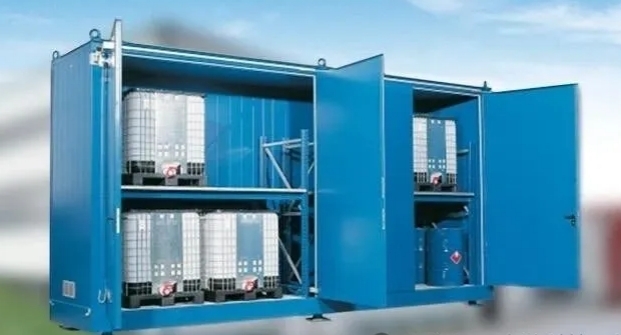When it comes to laboratory safety, most people first think of "visible" equipment such as fume hoods, goggles, and protective clothing. However, in the outdoor corners of many chemical laboratories, there hides an easily overlooked yet crucial safety facility — the outdoor hazardous chemicals explosion-proof container. Like a "firewall", it silently safeguards the safety of laboratory personnel and the surrounding environment. Today, we will take a closer look at this "invisible guardian" in the laboratory safety system.

First, let's look at a set of shocking data: In the past five years, 32% of laboratory hazardous chemical accidents were directly related to improper storage of hazardous chemicals. Among them, "temporary indoor storage of excessive flammable and explosive reagents" and "failure to promptly isolate leaking corrosive liquids" were the main causes. The outdoor explosion-proof container is designed to address these safety pain points.
What are the benefits of using outdoor hazardous chemicals explosion-proof containers? They transfer flammable, explosive, toxic and harmful hazardous chemicals (such as ethanol, ether, nitric acid, etc.) outside the main laboratory building, avoiding direct threats to the lives of laboratory personnel in the event of an accident. Moreover, the interior of the container is divided into zones in accordance with the requirements of the Material Safety Data Sheet (MSDS), realizing the principle of "separating acids from alkalis, isolating oxidants from reducers, and storing volatile substances separately", thus eliminating chemical reaction explosions caused by mixed storage at the source. One crucial point to add: Even if leakage or combustion occurs inside the container, its explosion-proof structure can effectively control the spread of flames and toxic gases, preventing the accident from expanding to the surrounding environment.
What makes a qualified outdoor hazardous chemicals explosion-proof container? It is by no means a simple "iron sheet shed", but a professional facility integrating multiple safety technologies.
The cabinet frame is mainly made of Corten A steel plates. The outer cabinet consists of a steel frame, vertically corrugated side plates and end faces, and fully horizontal roof panels. The cabinet adopts a double-layer thermal insulation structure, with Class A fireproof and heat-insulating materials used for the inner wall. A pressure relief opening is reserved on the wall or roof, which will open preferentially when the internal pressure reaches the set value, guiding the explosion energy to the outdoor open area and preventing the overall collapse of the structure.
The interior is equipped with a corrosion-resistant floor and covered with floor mats. In case of liquid leakage, the liquid can flow into the "leak-proof collection tank" to prevent it from seeping into the soil and causing pollution. It is also fitted with explosion-proof exhaust fans and equipped with flammable gas/toxic gas detectors, which will automatically alarm and start high-power exhaust ventilation when the concentration exceeds the standard. All lamps, switches and sockets inside the cabinet comply with the "explosion-proof grade standards", and the wires are protected by galvanized steel pipes to eliminate explosions caused by electric sparks.
Not only must the internal configuration effectively prevent explosions, but the external configuration is equally important. Warning signs shall be posted on the cabinet, such as "Flammable and Explosive", "Toxic and Harmful", and "No Open Flames". Meanwhile, a list of stored hazardous chemicals and emergency contact numbers shall be marked. An electrostatic discharge column for human bodies shall be equipped to eliminate static electricity on personnel, and an emergency eyewash and shower station shall be provided to conduct shower rinsing immediately in case of accidents.
Even with the perfect hardware of the explosion-proof container, it cannot do without standardized daily management. There are many seemingly "trivial matters" that must not be ignored. The storage capacity of hazardous chemicals in the cabinet shall not exceed the laboratory's 3-day usage, and the storage capacity of a single type of hazardous chemical shall not exceed 50 liters/kilograms (highly toxic chemicals shall be stored separately, with a total amount not exceeding 10 liters/kilograms). Moreover, they shall be zoned in accordance with the "Chemical Compatibility Chart", for example, the following:◦ Acidic reagents (hydrochloric acid, sulfuric acid) and alkaline reagents (sodium hydroxide, ammonia water) shall be stored on separate sides;◦ Oxidants (potassium permanganate, ammonium nitrate) shall be kept away from reducers (sulfur powder, zinc powder);◦ Volatile substances (ether, acetone) shall be stored in explosion-proof refrigerators or cool and ventilated areas, avoiding direct sunlight.
Finally, let's correct several common misunderstandings to avoid potential safety hazards caused by improper operations:Misunderstanding 1: "Since the container is explosion-proof anyway, it doesn't matter to store a little more."Correct View: The more the storage volume, the greater the risk when an accident occurs. Even with an explosion-proof structure, it cannot withstand the violent explosion caused by excessive hazardous chemicals. Strict quantity limitation is the bottom line.
Misunderstanding 2: "It's fine to put hazardous chemicals in ordinary plastic buckets."Correct View: Different hazardous chemicals require special containers. For example, highly corrosive reagents should be stored in polytetrafluoroethylene (PTFE) containers, and volatile substances in glass bottles with ground glass stoppers. Moreover, clear labels must be affixed to the outside of the containers.
Misunderstanding 3: "The container is outdoors, so frequent inspections are unnecessary."Correct View: The outdoor environment is more complex. Heavy rains may cause waterlogging, high temperatures may accelerate reagent decomposition, and strong winds may damage ventilation facilities. Daily inspections are indispensable.
Laboratory safety is no trivial matter—every detail is related to the safety of lives and the environment. Although the outdoor hazardous chemicals explosion-proof container may be inconspicuous, it is an indispensable part of the laboratory safety system. It is hoped that today's popular science can make more people pay attention to this "invisible guardian" and jointly build a solid safety line for laboratories.
